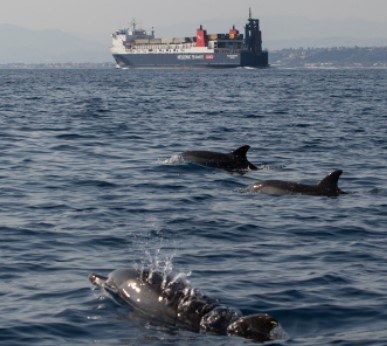An overview of anthropogenic underwater noise and its effects on marine mammal life (toothed whales)
A key adaptation to life in the water
To maximize survivability and utilization of resources in the aquatic marine environment, dolphins and other toothed whales have evolved and gained the ability to use echolocation. Echolocation is defined as “the process by which an organism projects acoustic signals in order to obtain a sense of their surroundings from the echoes it receives”. Toothed whales use this skill to recognise, locate and discriminate between various objects in three-dimensional space such as the open ocean.
This allows them to recognise potential prey and predators, as well as to navigate to specific locations that are known to be feeding hotspots . Many different species of cetaceans live in shallow offshore waters, bays and rivers with turbid water conditions leading to very limited underwater visibility, highlighting the cruciality of this adaptation in increasing their chances of survival.
A growing threat
As globalization increases, pressure on the global transport industry to meet shipping demands of products continue to rise. In order to be able to meet this rise in demand, transport companies have steadily been increasing their fleet size and vessel quantity through-out the years. If no effort is put forward to change current global trends, vessel traffic could be expected to increase by 70-75% within the next 20 years.
Fortunately, Anthropogenic noise has recently been recognised by various researchers as a major pollutant of international concern (1995) . This is due to the recognition that the increase in vessel passages and anthropogenic underwater noise has the potential to reduce both fish and whale communication space beyond the natural variability in background sound.
This may also have detrimental effects on animal populations as these populations get displaced from preferred feeding or breeding habitats as vessel activity alters their behavior. Reason being that cetaceans are especially reliant on the use of sound as it has a significant role for behavioral functions such as mating, echolocation of prey and orientation when conducting dives.
What has been done and how can you help?
To combat the rise of our ocean’s anthropogenic underwater noise pollution, it was proposed that an application or extension of ship speed restriction in ecologically significant areas because researchers have found a reduction in sound source from vessels when moving at lower speeds.
Furthermore, some government departments in many countries have started to regulate underwaternoise emission by implementing restrictions and a code of conduct when around marine mammals. In addition to this, they have instructed companies to undertake mandatory environmental impact assessments before executing any aquatic activity.
Lastly, apart from adhering to the restrictions and code of conduct, raising awareness and investment in ship quieting technology seems to be the most sustainable approach in reducing ship noise emissions in the long term. Reason being that this would enable transportation of goods to occur while minimizing the effects of anthropogenic sound on marine biodiversity.
Kenneth Manuel Research Intern References Au, W.W. and Simmons, J.A., 2007. Echolocation in dolphins and bats. Physics Today, 60(9), p.40. Jensen, F.H., Bejder, L., Wahlberg, M., Soto, N.A., Johnson, M. and Madsen, P.T., 2009. Vessel noise effects on delphinid communication. Marine Ecology Progress Series, 395, pp.161-175. Maybaum, H.L., 1993. Responses of humpback whales to sonar sounds. The Journal of the Acoustical Society of America, 94(3), pp.1848-1849.# Oelschläger, H.H., 2000. Morphological and functional adaptations of the toothed whale head to aquatic life. Historical Biology, 14(1-2), pp.33-39. Piantadosi, C.A. and Thalmann, E.D., 2004. Whales, sonar and decompression sickness. Nature, 428(6984), pp.1-2. Putland, R.L., Merchant, N.D., Farcas, A. and Radford, C.A., 2018. Vessel noise cuts down communication space for vocalizing fish and marine mammals. Global change biology, 24(4), pp.1708-1721. Richardson, W.J., Greene Jr, C.R., Malme, C.I. and Thomson, D.H., 2013. Marine mammals and noise.Academic press. Sivle, L.D., Kvadsheim, P.H., Fahlman, A., Lam, F.P., Tyack, P. and Miller, P., 2012. Changes in dive behavior during naval sonar exposure in killer whales, long-finned pilot whales, and sperm whales. Frontiers in Physiology, 3, p.400. Talpalar, A.E. and Grossman, Y., 2005. Sonar versus whales: noise may disrupt neural activity in deep-diving cetaceans. Undersea Hyperb Med, 32(2), pp.135-9.




























